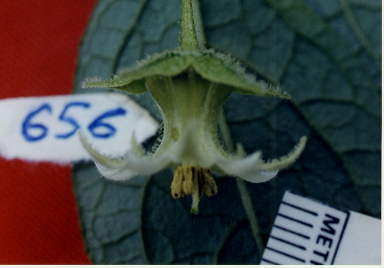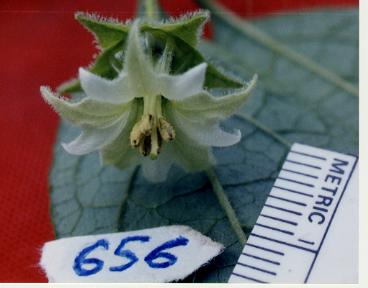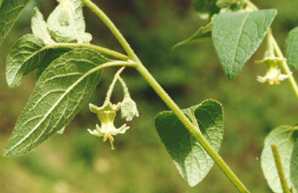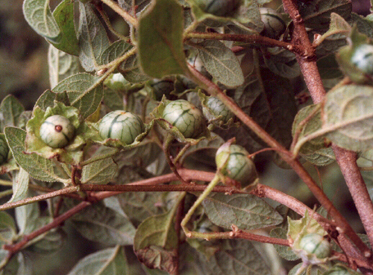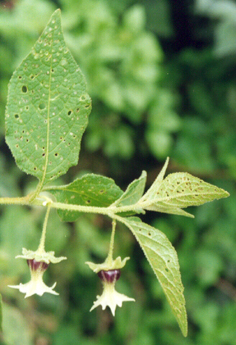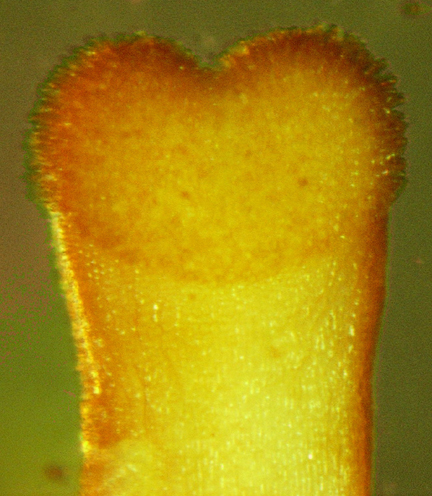TYPE: Peru. Cajamarca: Prov. Contumazá, Bosque Cachil, betw. Cascas and Contumazá, 2740 m, 16 Jun. 1999, S. Leiva G., T. Mione & L. Yacher 2356 (holotype, HAO; isotypes, F, MO, USN).
Frutex; laminae ad 8.7 x 5.3 cm, membranaceae, dendritici-piliferae pro maxima parte; inflorescentia 2- (3-) flora; corolla urceolata-tubulosa, pallide viridis, limbus 13--17.5 mm, lobis 10; stamina 10--16 mm, antherae 2--2.75 mm; styli 8--21 mm.
| Character |
Description |
Figures on this page |
| Habit & Height |
leaning shrub 0.7 to 4 m high |
|
Branches, young |
green, angular, lanate to glabrate with mostly dendritic hairs
and some interspersed finger hairs, not gland-tipped |
|
| older |
woody stems to 2.3 cm in diameter at base, terete, with lenticels, glabrous, light brown |
|
Leaves, size |
alternate, often geminate; the blade membranous to 8.7 X 5.3 cm |
1,2,3,4,5 |
| shape |
the blade ovate to lanceolate, the apex acute, the base rounded,
the margin entire to somewhat repand, ciliate |
|
| hairs |
densely to sparsely pubescent on both faces |
|
| petiole |
to 2.1 cm |
|
Inflorescence |
axillary, 2-(3) flowered and fruited |
|
| Peduncle & Pedicel |
15 (-21) mm; pedicel 7--20 mm; both terete, green, and densely to sparsely pubescent with dendritic hairs |
|
Calyx when flowering |
green, to 17 mm across, the lobes deltoid, adaxially glabrous, abaxially with a dense covering of mostly dendritic but some finger hairs, the margin ciliate |
1,2,3,5 |
| shape / position when flowering |
rotate to somewhat reflexed |
1,2,3,5 |
| at fruit maturity |
to 23 mm across |
|
Corolla color |
light-green, the lobules lighter than the lobes |
|
| shape and size |
urceolate-tubular, the tube 10--11 mm long,
the limb 13--18 mm across, slightly recurved |
|
| lobes / lobules |
10-total: narrowly triangular lobes 4 X 2.5 mm alternating with lobules |
|
| hairs |
abaxially sparsely pubescent with dendritic, finger and forked hairs and abundant glands, the margin ciliate |
|
Stamen length |
10--16 mm, exserted 1--8 mm beyond the mouth of the corolla |
|
| radial thickenings? |
yes |
|
| base expanded laterally? |
somewhat (ventral view) |
|
| filaments |
purple at base (not evident on pressed specimens), otherwise green, pubescent on proximal 20--40% of the length, the hairs simple and unpigmented |
|
| anther color |
not mentioned in protologue, not mentioned in Leiva 1998, almost certainly yellow |
3 |
| anther size |
2--2.75 mm |
|
| anther mucronate |
sometimes |
|
| anthers of a flower open simultaneously? |
|
|
| pollen quantity |
71,750 - 86,750 grains (n = 2 flowers) |
counts by CCSU student Elisabeth dos Santos. |
| pollen grain size |
range 29.63 to 34.32 micrometers, mean 31.55 micrometers (n = 14 grains) |
anthers were preserved in Peru in 70% ethanol and then pollen sat in cotton blue for 30 min before being measured |
| corona |
no |
|
| Stigma |
capitate, bilobed (often obscured by pressing), green, 0.5--1.1 mm, gynoecium glabrous except for stigma papillae 25 to 48 µm long |
|
| Disk around ovary |
disk broad, girdling base of ovary |
|
| Style length (hermaphroditic phase) |
8--21 mm, pale green |
|
| Nectar |
usually translucent, sometimes orange |
|
| Herkogamy? |
stigma exserted to 5.8 mm beyond anthers |
|
| Fruit color (at maturity) and size |
Berries subspherical, orange and to 13 mm across at maturity |
|
| Seeds |
light brown, 1.38--1.74 X 1.17--1.32 X 0.45--0.54 mm, sub-reniform to sub-orbicular |
|
| Chromosome number |
no data |
|
